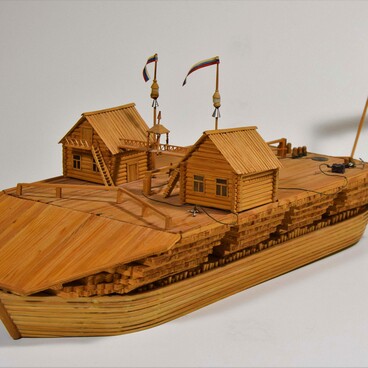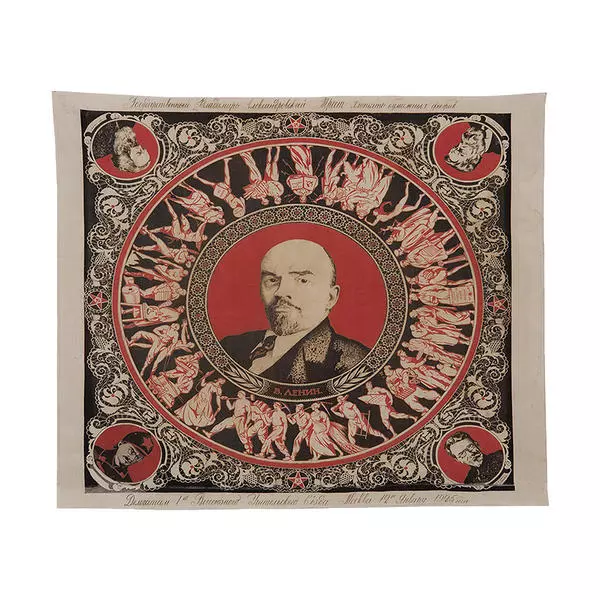Agitation Scarf, produced at ‘5th October’ Factory, issued in 1924. In the same year, soon after the release of trial run, these scarfs were produced in huge quantities. They were awarded to enterprise workers and honorary guests at the factory’s special events, in honor of the seventh anniversary of the October Revolution.
A chest portrait of Lenin sits in the middle of the scarf, with floral decoration and the inscription: ‘V. Lenin’. A frieze surrounds the central portrait. It is composed of many figures, similar to the painting on ancient Greek pottery. The artist draws a parallel between the scarf’s depiction of the representatives of the working proletariat and the heroes of ancient Greek myths. The figures of a printer, weaver, scientist, architect, astronomer, actor and peasants are depicted around Lenin.
This medallion is framed with ornaments, imitating lace. The ornament is complemented by four red stars, with a hammer and sickle in the center. There are portraits of Karl Marx, Friedrich Engels, Mikhail Kalinin and Leon Trotsky in each corner. The bottom-left portrait of Leon Trotsky, the first Chairman of the Revolutionary Military Council, has been painted over in ink. At the end of the 1920’s, the depiction of Trotsky, who had been declared as an enemy of the people and exiled from the country, was either painted over or cut out entirely.
The exhibited scarf belonged to a teacher at the First Grade Railway Unified Labor School, Viktor Kassin. Kassin was born in 1880 in the village of Vyazovka, Saratov province. Having graduated from teacher training college, he started to teach at a school with four year groups in Vyazovka in 1899. From 1907, Viktor Kassin moved to teach at the Railway Men’s Two Year Group School in Saratov. In 1919, he became a teacher at a Red Army school, and after three years he started to work at the First Grade Railway Unified Labor School. In 1925, Viktor Kassin was a delegate at the First All-Union Teaching Congress. The scarf was given to the delegates by Nadezhda Konstantinovna Krupskaya.
The scarf was given to the museum in 1982. It was donated by the original owner’s son, Evgeniy Kassin, an engineer at Saratov’s alkaline battery factory.
A chest portrait of Lenin sits in the middle of the scarf, with floral decoration and the inscription: ‘V. Lenin’. A frieze surrounds the central portrait. It is composed of many figures, similar to the painting on ancient Greek pottery. The artist draws a parallel between the scarf’s depiction of the representatives of the working proletariat and the heroes of ancient Greek myths. The figures of a printer, weaver, scientist, architect, astronomer, actor and peasants are depicted around Lenin.
This medallion is framed with ornaments, imitating lace. The ornament is complemented by four red stars, with a hammer and sickle in the center. There are portraits of Karl Marx, Friedrich Engels, Mikhail Kalinin and Leon Trotsky in each corner. The bottom-left portrait of Leon Trotsky, the first Chairman of the Revolutionary Military Council, has been painted over in ink. At the end of the 1920’s, the depiction of Trotsky, who had been declared as an enemy of the people and exiled from the country, was either painted over or cut out entirely.
The exhibited scarf belonged to a teacher at the First Grade Railway Unified Labor School, Viktor Kassin. Kassin was born in 1880 in the village of Vyazovka, Saratov province. Having graduated from teacher training college, he started to teach at a school with four year groups in Vyazovka in 1899. From 1907, Viktor Kassin moved to teach at the Railway Men’s Two Year Group School in Saratov. In 1919, he became a teacher at a Red Army school, and after three years he started to work at the First Grade Railway Unified Labor School. In 1925, Viktor Kassin was a delegate at the First All-Union Teaching Congress. The scarf was given to the delegates by Nadezhda Konstantinovna Krupskaya.
The scarf was given to the museum in 1982. It was donated by the original owner’s son, Evgeniy Kassin, an engineer at Saratov’s alkaline battery factory.




